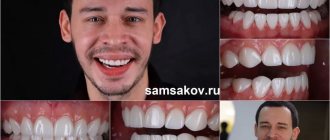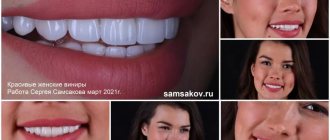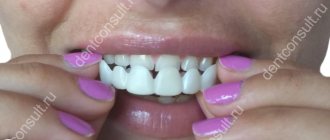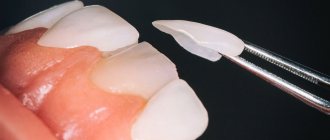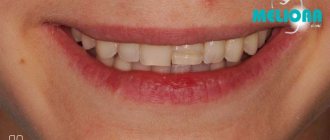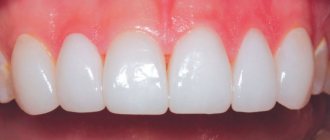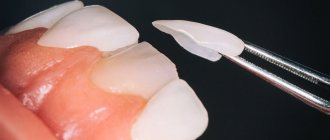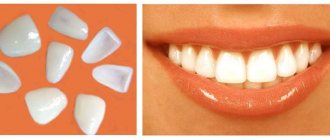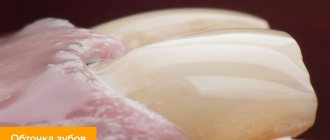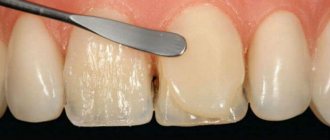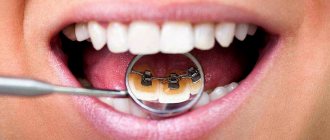A direct veneer is a microprosthesis applied in layers to the front surface of the tooth to give the required shape and color. It is created in the patient’s oral cavity immediately on the tooth from a light-activated filling composite material.
Direct veneers do not cure dental diseases. Its goal is to create an aesthetically beautiful appearance by correcting the color of the enamel or the shape of the tooth surface.
Veneers
The direct method is used to restore one or two teeth in the frontal group. They are not placed on posterior molars. When restoring a large number, other correction methods are used.
ATTENTION! For a full aesthetic appearance, it is recommended to simultaneously restore 10 front teeth on the lower and upper jaws.
Therapeutic (straight) onlays are used for minor defects:
- presence of interdental space;
- uneven teeth;
- small chip;
- darkening of tooth enamel when whitening does not give the required result;
- there are old fillings on the vestibular surface that create an unaesthetic appearance;
- slight curvature of the position in the row;
- increased tooth wear.
What are composite veneers and their composition
Composite (direct) veneers are special overlays on the front surface of the teeth, which are made from composite materials in the patient’s mouth. The reflective material is applied in layers directly to the surface of the teeth. One visit to the dentist is enough to complete the procedure.
A composite is a spatial three-dimensional combination of two or more chemical substances, in which there is a clear interface - it can be seen even with the naked eye. This combination enhances the properties of each component several times.
The first composite materials entered the dental market in 1964, but since then they have evolved, becoming more convenient and safer for humans, because during this period:
- new adhesives were created;
- the color scheme was improved;
- the strength of materials increased.
The main components of a modern composite:
- polymer matrix consisting of:
- polymerization inhibitor, which increases the shelf life of the substance;
- main and additional catalyst;
- activator;
- an ultraviolet absorber that prevents the color of the linings from changing when exposed to sunlight;
- inorganic filler, thanks to which:
- the aesthetic properties of microprostheses are increased, since the mineral filler has physical characteristics close to natural teeth;
- material deformation is prevented;
- the hardness and resistance of the composite increases;
- Surfactants or silanes are organosilicon compounds that increase the strength of the material.
Of these three components, the properties and differentiation of the composite are most influenced by fillers, which are classified based on the following characteristics:
- according to the material:
- from quartz;
- from silicon dioxide;
- from diamond dust;
- made of barium glass;
- According to the size of filler particles, there are composites from 0.04 to 45 microns;
- by particle shape:
- sticks;
- antennae;
- spirals;
- shavings;
- dust;
- ground.
Most dental composites used to make veneers are primarily composed of ground barium glass particles, but much depends on the manufacturer.
How veneers are installed indirectly
All orthopedic structures in dentistry are made individually, taking into account the structural features of the jaw, the location of the teeth, etc. every patient. Since there are no universal onlays that would suit everyone, the process of making and installing veneers using the indirect method can take two or more weeks. Veneers are generally placed in six stages:
- Primary examination and diagnosis.
- Approval of the treatment plan.
- Fitting and adjustment of the layout.
- Preparation (turning).
- Manufacturing and fitting of veneers.
- Installation and fixation.
Each stage requires an individual approach, and the methodology itself requires the use of unique elements that are suitable only for a specific person. To understand how veneers are placed, it makes sense to take a closer look at the manipulations at each stage.
You might be interested in:
Veneers
Composite veneers
Ceramic veneers
E-max veneers
Artistic restoration of teeth
Initial examination and diagnosis
Occurs during the first visit to the clinic for the purpose of further installation of veneers. At this stage, the following must happen:
- Oral examination
. In order to determine the scale of the problem and the level of tooth decay that requires restoration. At the same time, possible preliminary procedures are determined (for example, cleaning tartar, eliminating caries, etc.). Based on the general condition, an anamnesis is collected. - Confirmation of indications and verification of the absence of contraindications
. Veneers, as an option for artistic restoration, are not indicated for all dental defects. After examining the oral cavity, the dentist accurately determines whether veneers are suitable for solving the problem or whether other types of restoration should be preferred. In addition, the doctor must find out whether there are any contraindications. - Collection of analyzes
. Depending on the situation, this may include referrals for an X-ray or CT scan. The data obtained will allow the specialist to determine the condition of the bone tissue as accurately as possible and identify possible pathologies in order to prevent and/or prevent complications after the procedure. - Study of facial anatomy
. The dentist carefully examines the face as a whole, as well as specifically the mouth and lips and their relationship to the teeth. Very often at this stage photographs of the oral cavity are taken - the pictures will be used to draw up an individual treatment plan. - Discussion of the desired result
. Since beauty is a purely subjective concept, it is necessary to determine what aesthetic effect is expected by the patient. This is especially important in cases where overlays are needed not for 1-2 teeth, but for the entire smile area. Right now the desired shade and other cosmetic nuances are being discussed. - Scanning and impressions
. Depending on the situation, for further production of individual onlays, silicone impressions are made or, using an intraoral scanner, digital scanning is carried out. The data obtained is necessary in order to create a diagnostic model as accurately as possible and study the characteristics of the bite in detail. This data will also be used in the future for digital computer modeling.
When planning to install orthopedic structures, as an example and visual aids, you can provide photos of smiles that you like, asking to achieve the same result. If in doubt, you can always consult your doctor, who can give professional advice and offer the best options for the shade of veneers and other technical nuances.
Treatment plan approval
After collecting information during the initial examination, the specialist you contacted, in order to obtain the best desired effect, involves dentists of various specialties (for example, a hygienist, an orthodontist, a periodontist and an implantologist) in developing a treatment plan. Through joint efforts, the most effective solutions for a particular patient are determined. Thus, on your second visit to the clinic, you are provided with a complete treatment plan with an explanation of all its points. Based on the proposed option, you can ask any questions and ask for clarification on all the nuances related to how to install orthopedic structures.
Trying and adjusting the layout
Once the treatment plan is approved, a digital project will be ready within a week (or in some cases 10 days). You can see what your future smile will look like in a photo printed on a 3D printer.
The proposed option can be adjusted not only visually, but also practically - based on the 3D model, fitting plastic overlays are created that can be inserted into the mouth without preliminary turning or other manipulations. This will allow you to evaluate how the previously approved layout will look when you smile.
In order for patients to have the opportunity to “try on” new teeth, an impression is taken from the diagnostic model, which is a “silicone key”. It is filled with liquid plastic and placed in the oral cavity. After hardening, the “silicone key” is removed, and an exact copy of the future veneers remains in the patient’s mouth. This manipulation is called MOCK-UP.
This allows you not only to evaluate the future result from the outside, but also to make possible and necessary adjustments - ask to change the shape or size. At this stage, a discussion is held until the plan is fully approved - the desired adjustments are made to MOCK-UP (the material of the try-on veneers is easily adjusted and all “edits”, according to wishes, are made on the spot).
Once the mold has been finalized, a digital impression of the MOCK-UP is taken by scanning to create the exact same permanent veneers. In this case, the installation guarantees the most suitable version of orthopedic structures for your anatomical features.
Preparation (turning)
Approval of the shape, size and color of future veneers is the reason to begin the next stage of treatment - preparing the teeth for the installation of onlays. This requires turning (sawing) from the outside. The volume of tissue to be cut is determined individually and depends on the position of the teeth and the desired result. Before veneers are placed, grinding is mandatory for all patients without exception.
Since the turning procedure is uncomfortable, it is performed under anesthesia of your choice:
- punctual (an injection familiar to everyone);
- computer;
- drug-induced sleep (general sedation).
The last option is most often used when it is planned to install veneers over the entire smile area. Regardless of the anesthesia option chosen, turning, as a procedure requiring maximum precision, is performed using binoculars and an operating microscope.
After grinding, the gums are retracted - a special thread is installed into the gingival crevice (to clearly define the boundaries). This is required for more accurate production of veneers. After this, a scan is performed or silicone impressions are made.
At the end, temporary (adaptation) veneers are installed and fixed, which will protect the ground teeth and help you get used to your new smile. The service life of such linings is from two weeks to a couple of months. This time is enough to make permanent overlays.
Manufacturing and fitting of veneers
Some people are interested not only in how veneers are placed, but also in how they are made. It will not be possible to watch the process, since outsiders are not allowed to enter the dental laboratory. But, we are ready to talk about this process step by step:
- After receiving impressions, plaster models are cast.
- The resulting layout is digitized. To do this, a plaster cast is placed in a laboratory scanner and turned into a computer model.
- The dental technician begins to compare the actual situation with the desired result (based on the data obtained in the previous stages).
- Using a special computer program, the technician models future overlays.
- The finished model in the form of data is sent to a high-precision milling machine, which mills veneers from a ceramic blank block.
- The finished overlays are painted in a specified color and placed in special ovens for baking at high temperatures.
After this, fitting is carried out at the next appointment with the doctor. The overlays are fixed with try-on gel. This procedure allows you to evaluate the quality of fit, the resulting color and the degree of transparency.
Installation and fixation
Finally, the permanent veneers are installed and secured using a special adhesive to ensure a tight bond to the teeth. Thus, the long service life is guaranteed not only by the strength of the ceramic from which the onlays are made (its strength is several times greater than that of tooth enamel), but also by the solidity of their fixation. The installation itself looks like this:
- anesthesia is administered to avoid discomfort during the procedure;
- temporary overlays are removed;
- protection from moisture is provided in the place where the installation will be carried out (for this, a special thread or rubber scarf is used);
- the teeth are treated with an antiseptic, and then a special gel is applied to them, which is necessary to remove microorganisms and will provide enhanced fixation;
- The gel is washed off and the installation sites are dried;
- Special glue is applied to the teeth and veneers and the onlays are installed in their places;
- Special lamps are used to harden the glue.
After the veneers are installed, a routine examination will be required by the attending physician, who will assess the condition of the gums and, if necessary, perform spot grinding along the bite. Based on the results of this examination, recommendations for professional hygiene and oral cleaning will be issued.
Classification of composite onlays for teeth
Composite veneers are classified based on the number and size of particles they contain. According to this criterion, composite linings are divided into:
- cheap veneers with large composite particles (more than 30 microns): they quickly fade and cannot be further processed;
- overlays with mini-filler and particles up to 1.5 microns;
- hybrid composite veneers with particles measuring about 1 micron;
- microprostheses with microparticles (up to 0.04 microns), used exclusively to restore the aesthetic appearance of the front teeth.
Is it possible to replace an old veneer with a new one?
There is no exact service life and replacement time for old linings. The shade of the existing plates simply changes or their surface becomes leaky, and caries begins under the composite (if ceramics are installed, the development of caries is practically excluded). The clinic removes the old structure, the cost of the procedure is 3900 rubles per tooth. And a replacement is immediately selected for them.
There are frequent requests from patients who once had composite veneers installed, but today they would like to change them to ceramic ones, including those made using CEREC technology. Emax veneers are of ideal quality and speed of production. A new Cerec veneer can be obtained in 1.5 hours, and such veneers do not require an adjustment period.
How to create a Cerec overlay:
- The enamel is processed and the tooth is scanned. No cast needed.
- A three-dimensional model of the overlay is created taking into account the physical data.
- An automatic machine turns a prosthesis from an array of pressed ceramics.
- The veneer should be tried on and fixed.
If questions arise or the shade does not match, a corrected copy will be received within a few minutes. But such cases are rare. Veneers are ideally fixed even on uneven teeth - if the installation work is carried out by an experienced specialist. The perfect fit of the plates prevents bacteria and food particles from getting under the lining.
Indications for installation
Veneers made of composite material perfectly mask the following dental defects:
- abnormal shape of teeth;
- dental chips;
- wide spaces between teeth;
- uneven contours of the front teeth;
- displacement of crowns in the vertical plane;
- yellow or gray spots on the enamel that cannot be bleached;
- age-related change in enamel shade;
- thinning teeth;
- defect of the filling material: change in color of the filling, slight chipping;
- increased wear of crowns.
The installation of veneers is indicated if it is necessary to visually correct the condition of several teeth in the smile area. But in case of significant defects, it is more advisable to use other dental methods for correcting the dentition.
Historical reference
Composite materials are modified plastics with improved aesthetic, strength and handling properties. Their connection with tooth tissues is due to adhesion.
Adhesion (Latin adhesio - fusion, adhesion) is the phenomenon of adhesion between two surfaces brought into contact. Systems created on the basis of this phenomenon are widely used in dentistry.
Currently, there are seven generations of these systems , with the fourth to seventh being used in clinical practice. They differ from each other in adhesion strength, the relationship of the components (separately or in combinations) and indications for use.
The widespread use of veneers dates back to the 1980s.
Contraindications for installation
Direct veneering is contraindicated in the following cases:
- insufficient oral hygiene, as there is a high risk of developing caries directly under the linings;
- the presence of carious cavities;
- malocclusion and the need to wear braces;
- the presence of inflammatory processes in the mouth;
- bruxism;
- tooth mobility;
- erupting wisdom tooth;
- the presence of pulpless dental units, as they are more prone to destruction;
- serious enamel defects.
If the listed pathologies are eliminated, anyone can get direct composite veneers, and they will last for quite a long time.
Reviews
If you read reviews of direct veneers from the websites Otzovik and IRecommend , you can be convinced of the short service life of the structure. After several years of wearing a photopolymer overlay, it is still necessary to install a ceramic veneer, as chipping and tarnishing are inevitable. Straight cladding deteriorates especially quickly among smokers and coffee drinkers, because... absorb brown pigment.
The integrity and wearing period of direct veneers also greatly depends on the bite . People with straight bites usually leave negative reviews of direct composite veneers because... quickly chop off the extended cutting edge. With normal and distal occlusion, on the contrary, the linings can be worn longer, because the load on the upper front teeth is minimal.
The chosen material is also important. The best results in terms of strength and aesthetics are shown by the latest generation materials - nanohybrid composites with a high degree of filling and low shrinkage. These are photopolymers such as:
- Estelite (Japan);
- Enamel plus (Italy);
- Filtek (USA).
When choosing a doctor, make sure that he has previously used the direct composite veneer method; for this, ask for a portfolio of work. After completing the procedure, do not forget to follow the recommendations: give up bad habits, do not gnaw hard foods with your front teeth.
Also, in the first week after installation, you should completely give up tea, coffee, juices , because... It is at this time that dyes from the oral cavity are most absorbed. If chips occur, you should contact the same doctor, who will carry out restoration free of charge during the warranty period (1 year).
Advantages and disadvantages of veneering
The main advantages of composite veneers include:
- speed of production and installation: you don’t even need to make additional impressions;
- durability subject to proper use and quality care;
- beautiful appearance;
- maximum naturalness: modern composite materials transmit light well.
But composite veneers also have disadvantages:
- relative fragility, which manifests itself if a person does not take care of the pads and does not use suitable personal hygiene products;
- slight masking ability, which manifests itself in the presence of teeth that are too dark in color or bright, prominent spots (due to tetracycline);
- the need to grind down the enamel: after removing the veneers, the teeth need to be restored.
If only the central and lateral incisors are restored using veneering, then the remaining teeth often have to be whitened.
The quality of installation of veneer microprostheses depends on the skill of the dentist. Not all dentists can beautifully install veneers, so before installing them, it is recommended to check with the doctor about his track record and ask for photos of the work he has performed.
You should also pay attention to the cost of veneers, since professionals do not work at minimum prices. The approximate average cost of one direct composite veneer in Moscow and St. Petersburg is 8–9 thousand rubles. for one tooth . Minimum prices for composite veneers start from 4 thousand 500 rubles. Veneering is not covered by compulsory medical insurance, as it is a cosmetic procedure.
Popular questions
- Is turning necessary? Is it possible to install composite veneers without grinding?
Comparison of lumineer and lens thickness
Turning simulates the desired tooth shape, and in addition, an onlay without turning will look unnaturally wide and spoil the appearance. Turning is a necessary procedure.
However, there is a method of dental prosthetics that allows you to avoid grinding down the enamel at all. This method involves the use of lumineers, a thin plate whose width is only a few tenths of a millimeter. The price of such prostheses is significantly higher than average, and more durable materials are used in their manufacture.
- How are composite veneers different from ceramic veneers?
Ceramic plates are made of a different material. They are more expensive, but both the quality and shelf life correspond to the price.
- How to bleach them?
It is recommended that any veneers be whitened in a dental clinic with the help of a specialist.
- Is it worth installing?
It is definitely worth installing if the teeth need correction, and after consultation with a dentist, no contraindications were found.
- In what cases is replacement needed?
Replacement is necessary if the veneers have acquired a different shade or begun to crumble or crack. Replacement must be carried out without delay, and this must be done by a specialist.
- Is it possible to put composite veneers on crowns?
Attaching such an overlay to a crown is a complex procedure, especially since the structure is fragile. Experts do not recommend attaching dentures to crowns. Despite this, each case is individual. Even if the option of installing a veneer is excluded, the dentist will tell you how best to solve the problem
- Can it be used on all teeth?
It is possible if the budget allows it, and there are no contraindications to installation.
Stages of manufacturing direct composite veneers
It is better to do dental overlays in the first half of the day, when it is light and sunny. This will help the dentist correctly select the shade of the material. Direct veneers are made in the patient's mouth. The whole procedure consists of several stages:
- Visual inspection and sanitation of the oral cavity. A few days before the procedure, you can undergo a professional teeth cleaning session.
- Choosing the shade of veneers according to the Vita scale. The most responsible approach to choosing the color of the composite material is if you need to place literally 1-2 veneers and you want these veneers to be no different from the rest of the dentition.
- Hardware grinding of the teeth to which the composite material will be applied.
- Applying layers of composite material to the front surface of the teeth. Typically, 7 layers of material are required to achieve maximum strength of a microprosthesis.
- Turning and grinding of veneers.
Main advantages
- Affordable price. The cost of composite products is lower than ceramic products.
- The preparation of tooth tissue for composite veneers is minimal and does not affect the deeper sensitive layers.
- Composite veneers are installed in one visit to a dentist at a medical clinic.
- The products completely match the color of the enamel of the patient’s own teeth.
Product service life
Manufacturers of veneers claim that microprostheses can last in the mouth for about 5–6 years, but in fact it is better to focus on a period of 3–4 years. Moreover, the veneer will lose its whiteness and shine approximately a year after installation, which is due to the large amount of dyes consumed in food and a violation of the acid-base balance in the oral cavity.
Changing the color of veneers is facilitated by:
- red wine;
- spices like curry;
- coffee;
- strong tea;
- colored carbonated drinks.
After veneering, it is recommended to avoid coloring products or reduce their consumption to a minimum. If a person smokes, then it is better for him to install ceramic veneers rather than composite ones. Composites are easily stained from exposure to cigarette smoke.
Caring for therapeutic veneers
Aspects and rationales for care relate to the intricacies of the composition and installation of therapeutic veneers. Recommended:
- Avoid putting pressure on teeth with onlays;
- Minimize the content of brightly colored foods and drinks with dyes in the diet;
- Love hygiene and carefully observe it;
- Visit your dentist regularly.
Composite veneers come in handy when you want to quickly and inexpensively transform your smile. If the defects are not too strong and there are no contraindications, it is worth taking advantage of the achievements of dentistry and changing the appearance of the teeth.
Componeer direct composite veneers
Componers are used to improve the color of the surface of teeth and to restore their shape. They are ready-made enamel overlays. Installation of compositors is faster and easier due to the fact that the period of preparation of the oral cavity for restoration is reduced.
Componers cannot be installed if:
- occlusion;
- periodontal pathologies;
- parafunction of masticatory muscles;
- significant tooth decay.
There is no grinding when installing composites, which preserves the appearance and health of the treated teeth. If microprostheses need to be removed in the future, no additional enamel restoration will be required.
Do veneers damage teeth or not?
Let's destroy this incomprehensible myth that veneers ruin teeth!
Caries spoils teeth. Veneers, on the contrary, are a so-called protective suit against caries and external influences. According to the manufacturing method, they are of two types: direct and indirect.
Direct ones are made directly in the oral cavity, and indirect ones are made in a dental laboratory. It is necessary to take into account the fact that they are made from materials that are biocompatible with the body and do not cause allergies or other reactions.
And the high-quality German E-Max ceramics that we use does not cause any side effects, does not change its color and remains natural for many years.
Dentists recommend installation from the age of 18, since they cannot be placed on baby teeth. To install them, the teeth must be permanent. Many people often have the question of what to do if the tooth under the veneer begins to hurt. There's nothing wrong with that! Since they are installed from the outside, the back side allows any manipulation of the tooth.
We guarantee you 100% safety of dental procedures at SmileStudio. Our highly qualified doctors with 10 years or more experience do their work efficiently, painlessly and as quickly as possible.
Photos before and after installing veneers using the direct method
Teeth before and after installation of veneers
Teeth affected by fluorosis before and after veneering
Installing direct composite veneers is a relatively inexpensive way to make your smile beautiful and snow-white. This procedure is carried out for many pathologies, but the durability and naturalness of microprostheses depend on the professionalism of the dentist and the equipment of the dental clinic.
What happens after the procedure
The person leaves the clinic with a beautiful smile and returns to everyday life. In an effort to extend the service life of composite veneers, the patient is obliged to follow the recommendations of the attending physician. Oral hygiene is performed as usual, the constant use of floss is recommended, and a desire is expressed to buy an irrigator for better cleaning of teeth.
After 30 days, a follow-up appointment will follow, at which the dentist will examine the veneer and monitor the patient’s compliance with the rules of care. Once every six months, polishing of the composite will be required to maintain the presentable appearance of the lining. Of course, if the integrity of the veneer is compromised or there is suspicion of caries arising under the structure, an appointment with a doctor is required.
